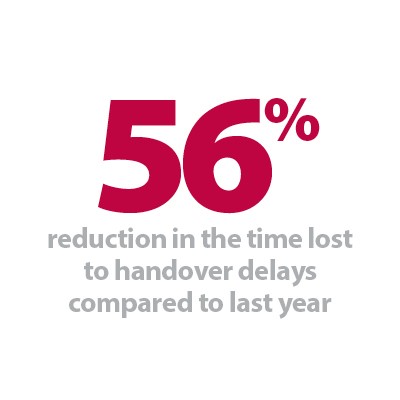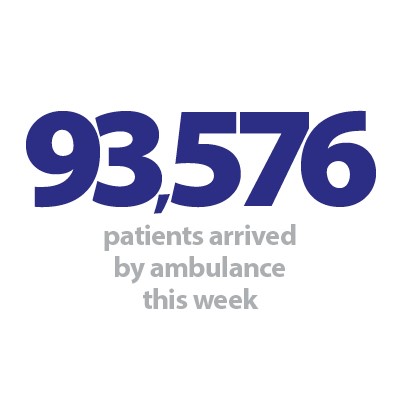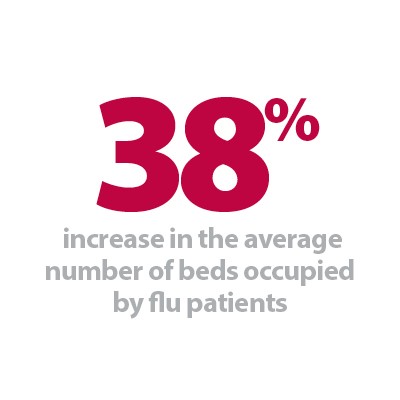


Introduction
Today NHS England published another release of its weekly winter situation reports, providing a snapshot of activity across emergency care and hospitals, and insight into trust performance, covering the period 25-31 December.
This week's figures remind us of the impact of seasonal pressures on the NHS as we see more patients in hospital with flu and Covid-19, both providing cause for concern. These data also show us how staff are working tirelessly under severe pressure to give patients safe, high-quality care amid ongoing seasonal illnesses.
We are seeing encouraging reductions in some areas, for example hours lost due to ambulance handover delays, which are down by over half compared to last year, and decreases in general and acute (G&A) bed occupancy and patients in hospital with diarrhoea and vomiting (D&V) and norovirus.
Winter situation report (25 – 31 December)
A&E closures and diverts: There were no A&E closures this week. There were 20 A&E diverts, seven more than the week prior and three more than the same week last year.
Ambulance arrivals: A total of 93,576 patients arrived by ambulance, an increase of 0.1% since last week and up by 31.4% compared to the same week last year.
Ambulance handovers: 28.9% of ambulance handovers were delayed by 30 minutes or more, up from 22.9% last week but down from 43.7% at the same point last year. 11.7% were delayed by 60 minutes or more. This is up from 7.2% last week but down from 26.3% since the same week last year. A total of 24,384 hours were lost to ambulance handover delays, this is down by 56% compared to this time last year (54,853).
Critical care: Adult critical care bed occupancy is at 74.9% this week, down from the week before (77.6%).
Diarrhoea and vomiting (D&V): The number of beds closed due to D&V and norovirus decreased this week, with an average of 486 closed per day. This is down from 580 last week.
Discharges: There were an average of 19,535 patients each day who no longer met the criteria to reside this week, a decrease of 15% (3,514 less) from the week prior. Of these, almost six in ten (58.8%, 11,478) remained in hospital, a larger proportion than the week prior (49.6%).
Flu: This week the average number of G&A beds occupied by flu patients each day increased by 38% to 1,232, up from 894 last week. An average of 81 critical care beds were occupied by flu patients each day this week (67% more than the week before).
General and acute (G&A) beds: There were an average of 100,008 G&A beds open each day across all acute trusts. On average each day, 94 G&A beds were unavailable and void to non-Covid admissions. Average bed occupancy dropped this week to 89.5%.
Long stay: The number of patients staying in hospital longer than seven days decreased since last week (down by 2.1%), but those staying longer than 14 and 21 days has remained at a similar level.
Neonatal intensive care beds: For all trusts, bed occupancy has increased slightly from last week and is at 68.8%; this is up from 68.3% last week. The average number of care beds open is at 1,718, 2% lower than last week.
Paediatric intensive care beds: For all trusts, bed occupancy has decreased this week to 76.5%, down from 81.7% last week. The average number of care beds open has slightly risen this week to 365, up by 0.8%. The average number of care beds available has risen to 86 (20 more than last week).
Respiratory syncytial virus (RSV): An average of 52 beds were closed this week due to RSV symptoms, down from 78 last week and down from 88 last year.
Staff absences: There were an average of 47,779 total absences each day this week, of which 5% were Covid-19 related (2,378). The total number of staff absences has decreased from the week before, but the proportion of Covid-19 related absences has remained the same (5%).
Our view
The data released today illustrate the impact of ongoing seasonal illnesses on the healthcare system. Trusts continue to work hard to deliver high-quality care for patients as they navigate through this difficult period.
In particular, today's figures highlight the significant pressures that ambulance staff are working under as this week saw over 93,500 patients arriving at hospital by ambulance – up by over a third from last year and the busiest week so far this winter. However, these data also demonstrate the enormous efforts of these staff; hours lost due to handover delays were 56% lower than the same week last year, an impressive improvement.
Furthermore, challenges from seasonal illnesses persist. Flu cases in hospital have increased by over one third this week (38%), with 1,232 patients with flu in G&A hospital beds, and patients with flu in critical care beds increasing by over two thirds (67%) to 81. On top of this, the latest month has seen a 72% increase in the number of patients in hospitals with Covid-19, adding to the pressures felt across the health and care sectors.
Delayed discharges also remain a problem for trusts, with almost 59% of medically fit patients remaining in hospital this week, a larger proportion than the week before and the highest so far this winter.
These winter pressures are compounded by workforce gaps. We continue to see high levels of staff absences, averaging almost 48,000 this week, and trust leaders face a six-day walkout by junior doctors this week, the longest ever consecutive strike action taken in the history of the NHS.